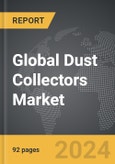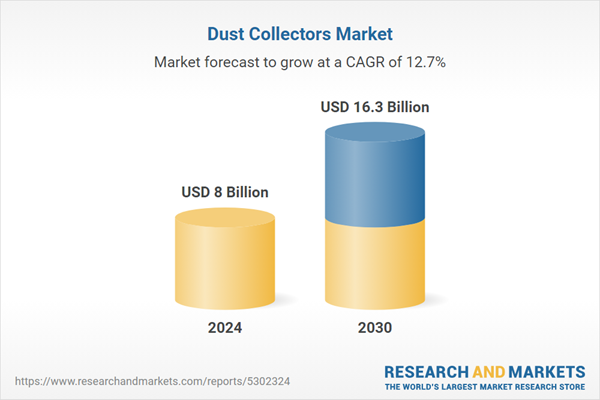The global market for Dust Collectors was valued at US$8.0 Billion in 2024 and is projected to reach US$16.3 Billion by 2030, growing at a CAGR of 12.7% from 2024 to 2030. This comprehensive report provides an in-depth analysis of market trends, drivers, and forecasts, helping you make informed business decisions. The report includes the most recent global tariff developments and how they impact the Dust Collectors market.
Segments: End-Use (Residential, Commercial, Other End-Uses).
Geographic Regions/Countries: World; United States; Canada; Japan; China; Europe (France; Germany; Italy; United Kingdom; Spain; Russia; and Rest of Europe); Asia-Pacific (Australia; India; South Korea; and Rest of Asia-Pacific); Latin America (Argentina; Brazil; Mexico; and Rest of Latin America); Middle East (Iran; Israel; Saudi Arabia; United Arab Emirates; and Rest of Middle East); and Africa.
The analysts continuously track trade developments worldwide, drawing insights from leading global economists and over 200 industry and policy institutions, including think tanks, trade organizations, and national economic advisory bodies. This intelligence is integrated into forecasting models to provide timely, data-driven analysis of emerging risks and opportunities.
Global Dust Collectors Market - Key Trends and Drivers Summarized
Why Are Dust Collectors Critical for Industrial and Environmental Safety?
Dust collectors play an essential role in maintaining air quality, both in industrial environments and for overall environmental health. These systems are designed to capture and filter airborne dust, debris, and particulate matter generated by industrial processes such as metalworking, woodworking, mining, and cement production. Without proper dust collection, fine particles can not only create hazardous working conditions but also pose significant health risks, including respiratory diseases and long-term exposure-related conditions like silicosis. Dust collectors help ensure compliance with stringent environmental regulations set by organizations like OSHA (Occupational Safety and Health Administration) and the EPA (Environmental Protection Agency), which are designed to protect both workers and the environment. Additionally, they help safeguard equipment by reducing the wear and tear that dust can cause to machinery, leading to increased operational efficiency and reduced maintenance costs. As industries increasingly focus on worker safety and environmental responsibility, dust collectors have become an integral component in minimizing air pollution and enhancing workplace safety.How Are Technological Advancements Enhancing the Performance of Dust Collectors?
Technological innovations have significantly improved the design, efficiency, and functionality of dust collectors, making them more effective in controlling particulate emissions while being energy-efficient. One of the key advancements is the development of high-efficiency particulate air (HEPA) filters, which can capture extremely fine particles, including dust, allergens, and harmful pollutants as small as 0.3 microns. These filters have become a standard in industries where air quality control is critical, ensuring that even the smallest particles are effectively trapped, thus improving the overall safety of the workplace. Moreover, advancements in pulse jet cleaning systems, which remove dust buildup from the filter media, have improved the longevity and performance of dust collectors, allowing them to operate continuously with minimal maintenance. Automation and IoT (Internet of Things) integration have also brought new capabilities to dust collectors. Smart systems now monitor air quality and automatically adjust suction power or filter cleaning cycles, optimizing performance and energy use. Real-time data tracking allows facility managers to assess the efficiency of their dust collection systems, make predictive maintenance decisions, and ensure compliance with air quality standards. Furthermore, innovations in dust collector design, such as modular systems and improved airflow dynamics, have allowed industries to customize dust collection solutions that meet the specific needs of their operations while reducing energy consumption and operational costs.How Are Changing Industry Regulations and Consumer Demands Shaping the Dust Collector Market?
The dust collector market is being increasingly influenced by stricter industry regulations and rising consumer expectations around health, safety, and sustainability. Governments and regulatory bodies worldwide are imposing tighter restrictions on air emissions and workplace safety standards, particularly in industries that generate large volumes of dust and particulate matter, such as mining, construction, and manufacturing. Compliance with these regulations requires companies to invest in advanced dust collection systems that effectively capture harmful particles and maintain safe working environments. As a result, the demand for high-performance dust collectors has grown significantly, particularly for systems that meet or exceed these regulatory requirements. In addition to regulatory pressures, there is a growing consumer demand for environmentally responsible practices and products. Companies that invest in efficient dust collection systems demonstrate their commitment to sustainability and worker safety, which can enhance their reputation and brand loyalty. The rise of 'green' certifications and sustainability initiatives has pushed manufacturers to adopt dust collectors that not only capture emissions but also reduce energy consumption and minimize waste. Furthermore, with the growing focus on worker health and well-being, industries are increasingly prioritizing air quality management to protect employees from exposure to harmful dust and chemicals.What’s Driving Growth in the Dust Collector Market?
The growth in the dust collector market is driven by several key factors, including stricter environmental regulations, the expansion of heavy industries, and the increasing need for workplace safety and efficiency. One of the primary drivers is the implementation of more stringent air quality regulations across various sectors, particularly in industries that generate significant dust emissions, such as mining, construction, cement production, and metalworking. Regulatory bodies like OSHA and the EPA mandate the installation of dust collection systems to ensure that industrial processes comply with air quality standards, driving demand for more advanced and efficient dust collectors. These regulations are becoming even more rigorous as environmental concerns intensify globally, pushing industries to adopt cleaner technologies and reduce their environmental footprint. Another important factor driving market growth is the rise in industrial activity, particularly in emerging markets where infrastructure development and manufacturing are expanding rapidly. The increase in construction, energy, and manufacturing projects has resulted in a higher demand for dust collectors to control emissions and ensure safe working conditions. Additionally, as industries increasingly automate and scale up operations, the need for more sophisticated dust collection systems that can handle larger volumes of dust and particulate matter efficiently has grown. Technological advancements are also playing a significant role in market expansion. The development of smart, energy-efficient dust collectors with automated controls, predictive maintenance features, and real-time monitoring capabilities has made these systems more attractive to industries looking to optimize operational efficiency and reduce energy costs. The growing emphasis on sustainability is encouraging companies to invest in eco-friendly dust collection systems that minimize energy consumption and waste, further fueling market growth. Finally, as worker health and safety become a top priority for industries worldwide, the demand for dust collectors that can protect employees from harmful airborne particles continues to rise, making these systems an indispensable part of modern industrial operations.Report Scope
The report analyzes the Dust Collectors market, presented in terms of units. The analysis covers the key segments and geographic regions outlined below.Segments: End-Use (Residential, Commercial, Other End-Uses).
Geographic Regions/Countries: World; United States; Canada; Japan; China; Europe (France; Germany; Italy; United Kingdom; Spain; Russia; and Rest of Europe); Asia-Pacific (Australia; India; South Korea; and Rest of Asia-Pacific); Latin America (Argentina; Brazil; Mexico; and Rest of Latin America); Middle East (Iran; Israel; Saudi Arabia; United Arab Emirates; and Rest of Middle East); and Africa.
Key Insights:
- Market Growth: Understand the significant growth trajectory of the Residential segment, which is expected to reach US$8.7 Billion by 2030 with a CAGR of a 13.5%. The Commercial segment is also set to grow at 12.1% CAGR over the analysis period.
- Regional Analysis: Gain insights into the U.S. market, valued at $2.0 Billion in 2024, and China, forecasted to grow at an impressive 16.7% CAGR to reach $4.0 Billion by 2030. Discover growth trends in other key regions, including Japan, Canada, Germany, and the Asia-Pacific.
Why You Should Buy This Report:
- Detailed Market Analysis: Access a thorough analysis of the Global Dust Collectors Market, covering all major geographic regions and market segments.
- Competitive Insights: Get an overview of the competitive landscape, including the market presence of major players across different geographies.
- Future Trends and Drivers: Understand the key trends and drivers shaping the future of the Global Dust Collectors Market.
- Actionable Insights: Benefit from actionable insights that can help you identify new revenue opportunities and make strategic business decisions.
Key Questions Answered:
- How is the Global Dust Collectors Market expected to evolve by 2030?
- What are the main drivers and restraints affecting the market?
- Which market segments will grow the most over the forecast period?
- How will market shares for different regions and segments change by 2030?
- Who are the leading players in the market, and what are their prospects?
Report Features:
- Comprehensive Market Data: Independent analysis of annual sales and market forecasts in US$ Million from 2024 to 2030.
- In-Depth Regional Analysis: Detailed insights into key markets, including the U.S., China, Japan, Canada, Europe, Asia-Pacific, Latin America, Middle East, and Africa.
- Company Profiles: Coverage of players such as AAF International, Alstom, Camfil APC, CECO Environmental, Donaldson and more.
- Complimentary Updates: Receive free report updates for one year to keep you informed of the latest market developments.
Some of the 36 companies featured in this Dust Collectors market report include:
- AAF International
- Alstom
- Camfil APC
- CECO Environmental
- Donaldson
- Feida
- FLSMIDTH
- Hamon
- Jiehua
- Kelin
- Longking
- Nederman
- Sinoma
- Xinzhong
Tariff Impact Analysis: Key Insights for 2025
Global tariff negotiations across 180+ countries are reshaping supply chains, costs, and competitiveness. This report reflects the latest developments as of April 2025 and incorporates forward-looking insights into the market outlook.The analysts continuously track trade developments worldwide, drawing insights from leading global economists and over 200 industry and policy institutions, including think tanks, trade organizations, and national economic advisory bodies. This intelligence is integrated into forecasting models to provide timely, data-driven analysis of emerging risks and opportunities.
What’s Included in This Edition:
- Tariff-adjusted market forecasts by region and segment
- Analysis of cost and supply chain implications by sourcing and trade exposure
- Strategic insights into geographic shifts
Buyers receive a free July 2025 update with:
- Finalized tariff impacts and new trade agreement effects
- Updated projections reflecting global sourcing and cost shifts
- Expanded country-specific coverage across the industry
Table of Contents
I. METHODOLOGYII. EXECUTIVE SUMMARY2. FOCUS ON SELECT PLAYERSIII. MARKET ANALYSISIV. COMPETITION
1. MARKET OVERVIEW
3. MARKET TRENDS & DRIVERS
4. GLOBAL MARKET PERSPECTIVE
UNITED STATES
CANADA
JAPAN
CHINA
EUROPE
FRANCE
GERMANY
ITALY
UNITED KINGDOM
SPAIN
RUSSIA
REST OF EUROPE
ASIA-PACIFIC
AUSTRALIA
INDIA
SOUTH KOREA
REST OF ASIA-PACIFIC
LATIN AMERICA
ARGENTINA
BRAZIL
MEXICO
REST OF LATIN AMERICA
MIDDLE EAST
IRAN
ISRAEL
SAUDI ARABIA
UNITED ARAB EMIRATES
REST OF MIDDLE EAST
AFRICA
Companies Mentioned (Partial List)
A selection of companies mentioned in this report includes, but is not limited to:
- AAF International
- Alstom
- Camfil APC
- CECO Environmental
- Donaldson
- Feida
- FLSMIDTH
- Hamon
- Jiehua
- Kelin
- Longking
- Nederman
- Sinoma
- Xinzhong
Table Information
| Report Attribute | Details |
|---|---|
| No. of Pages | 92 |
| Published | April 2025 |
| Forecast Period | 2024 - 2030 |
| Estimated Market Value ( USD | $ 8 Billion |
| Forecasted Market Value ( USD | $ 16.3 Billion |
| Compound Annual Growth Rate | 12.7% |
| Regions Covered | Global |









